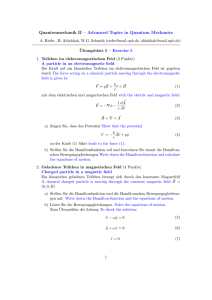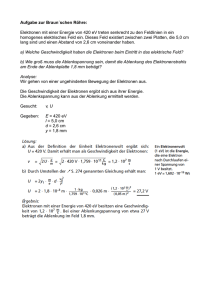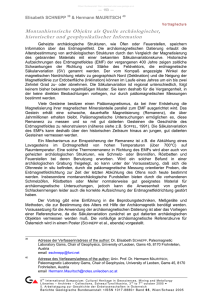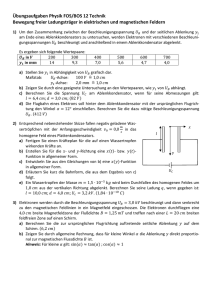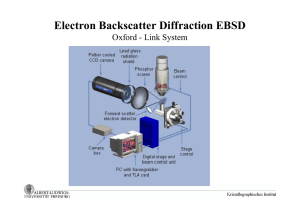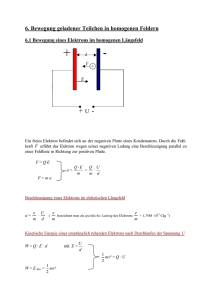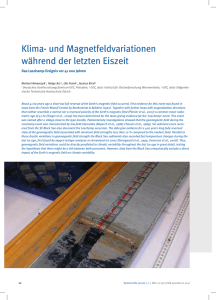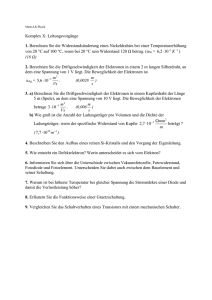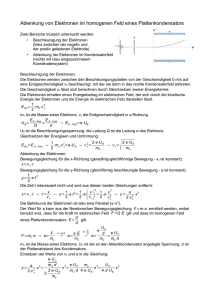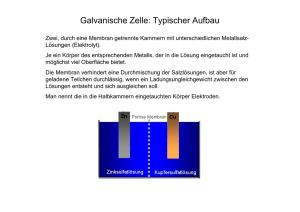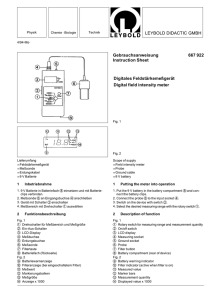UE307050 Thomson Tube
Werbung
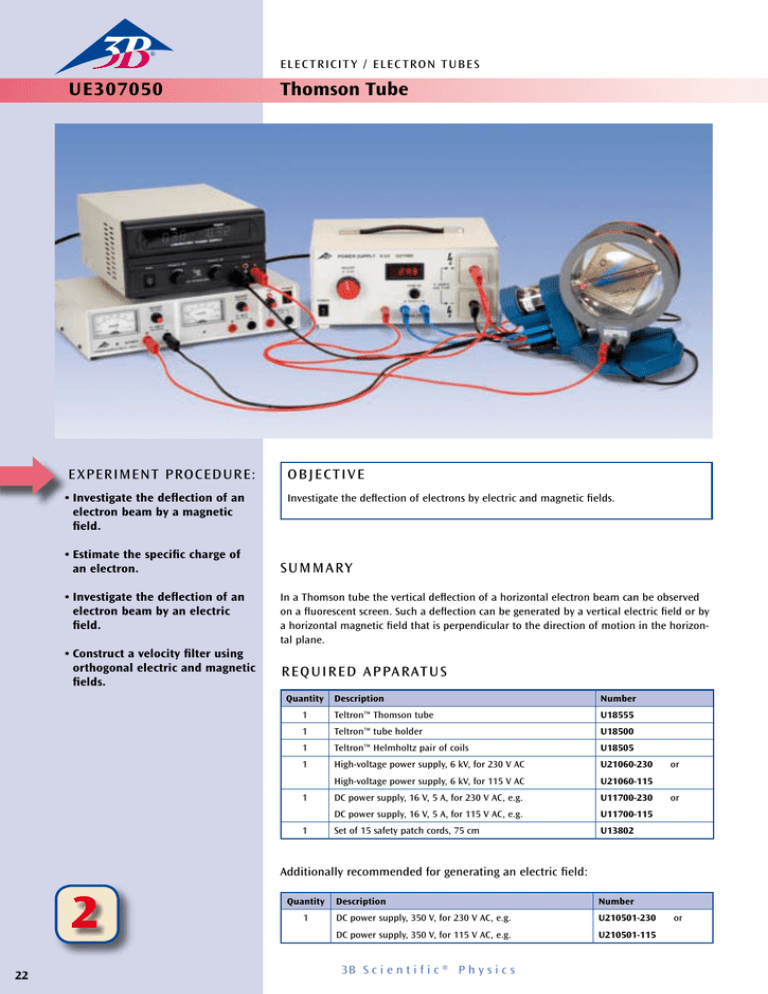
El e c tr ic it y / el e c tron t ubes UE307050 E XPERIMENT PROCEDURE: •Investigate the deflection of an electron beam by a magnetic field. •Estimate the specific charge of an electron. •Investigate the deflection of an electron beam by an electric field. •Construct a velocity filter using orthogonal electric and magnetic fields. Thomson Tube O BJE CTIVE Investigate the deflection of electrons by electric and magnetic fields. S UMMARY In a Thomson tube the vertical deflection of a horizontal electron beam can be observed on a fluorescent screen. Such a deflection can be generated by a vertical electric field or by a horizontal magnetic field that is perpendicular to the direction of motion in the horizontal plane. r equir ed a pparatus Quantity Description Number 1 Teltron™ Thomson tube U18555 1 Teltron™ tube holder U18500 1 Teltron™ Helmholtz pair of coils U18505 1 High-voltage power supply, 6 kV, for 230 V AC U21060-230 High-voltage power supply, 6 kV, for 115 V AC U21060-115 1 DC power supply, 16 V, 5 A, for 230 V AC, e.g. U11700-230 DC power supply, 16 V, 5 A, for 115 V AC, e.g. U11700-115 Set of 15 safety patch cords, 75 cm U13802 1 or or Additionally recommended for generating an electric field: 2 22 Quantity 1 Description Number DC power supply, 350 V, for 230 V AC, e.g. U210501-230 DC power supply, 350 V, for 115 V AC, e.g. U210501-115 3B S c i e n t i f i c ® P h y s i c s or El e c tr ic it y / el e c tron t ubes Thomson Tube UE307050 BA SIC PRINCIPLE S In a Thomson tube electrons pass horizontally through a slit behind the anode and impinge upon a fluorescent screen placed at an angle to the electron beam and upon which they can be observed. Beyond the slot there is a plate capacitor. The electric field between its two plates deflects the electron beam in a vertical direction. In addition Helmholtz coils can be used to rate a magnetic field in a horizontal direction perpendicular to the motion of the electrons that also deflects them in a vertical direction. If a voltage UP is being applied to the plate capacitor, electrons are deflected vertically by its electric field E with a force (5) e: charge of an electron This deflection is also vertical (see Fig. 2). The electric field can thus be adjusted in such a way that it precisely cancels out the deflection due to the magnetic field: e ⋅E + e ⋅v ⋅B = 0 (6) An electron moving at velocity v in a direction perpendicular to a magnetic field B is subject to a Lorentz force given by (1) e: charge of an electron F = −e ⋅ E In this case it is easy to determine the velocity of each electron: F = −e ⋅ v × B The force acts in a direction orthogonal to a plane defined by the direction movement and the magnetic field. This causes the beam to be deflected vertically if the direction of motion and the magnetic are both in the plane of the horizontal (see Fig. 1) If the direction of motion is perpendicular to a uniform magnetic field, electrons are deflected in a circular path subject to a centripetal force given by the Lorentz-force. v2 m⋅ = e ⋅v ⋅B (2) r m: mass of an electron, r: radius of path. E v= (7) B Such an arrangement of orthogonal electric and magnetic fields in which the deflection of the beam, is cancelled out is sometimes called a velocity filter. E VALUATION The velocity of the electrons depends on the anode voltage UA so that: e (3) v = 2 ⋅ ⋅ UA m This means that measuring the radius of the path allows the specific charge of an electron to be determined as long as the homogenous magnetic field B and the anode voltage UA are both known. Equations (2) and (3) can be combined to give an expression for the specific charge of a electron: The magnetic field B is generated by a pair of Helmholtz coils and is proportional to the current IH passing through each coil individually. The coefficient of proportionality k can be determined from the coil radius R = 68 mm and the number of turns in the coil N = 320 per coil: 3 B = k ⋅ IH 4 Vs N where k = 2 ⋅ 4π ⋅ 10−7 ⋅ Am R 5 The electric field can be calculated from the voltage UP and the separation of plates d: E= UP d 2 ⋅ UA e = m (B ⋅ r )2 (4) UF UP UA UF UA UH = R IH Fig. 1: Schematic of a Thomson tube in a magnetic field Fig. 2: Schematic of a Thomson tube in an electric field ...going one step further 23 ELEKTRIZITÄTSLEHRE / ELEKTRONENSTRAHL-RÖHREN UE307050 AUF GABEN: •Untersuchung der Ablenkung eines Elektronenstrahls in einem magnetischen Feld. •Abschätzung der spezifischen Ladung des Elektrons. •Untersuchung der Ablenkung eines Elektronenstrahls in einem elektrischen Feld. •Aufbau eines Geschwindigkeitsfilters aus gekreuztem elektrischem und magnetischem Feld. Thomson-Röhre ZIEL Untersuchung der Ablenkung von Elektronen im elektrischen und magnetischen Feld. Z US AMM ENFASSUNG In der Thomson-Röhre wird die vertikale Ablenkung eines horizontalen Elektronenstrahls auf einem Leuchtschirm sichtbar. Die Ablenkung kann durch ein vertikales elektrisches Feld erzeugt werden oder durch ein horizontales magnetisches Feld, das in der horizontalen Ebene senkrecht zur Strahlrichtung steht B enötigte Geräte Anzahl Geräte Art.-Nr. 1 Teltron™ Thomson-Röhre U18555 1 Teltron™ Röhrenhalter U18500 1 Teltron™ Helmholtz-Spulenpaar U18505 1 Hochspannungs-Netzgerät 6 kV, für 230 V AC U21060-230 Hochspannungs-Netzgerät 6 kV, für 115 V AC U21060-115 1 DC-Netzgerät 16 V, 5 A, für 230 V AC, z.B. U11700-230 DC-Netzgerät 16 V, 5 A, für 115 V AC, z.B. U11700-115 1 Satz 15 Sicherheits-Experimentierkabel, 75 cm U13802 oder oder Zusätzlich empfohlen zur Erzeugung eines elektrischen Felds: 2 22 Anzahl 1 Geräte Art.-Nr. DC-Netzgerät, 0-350 V DC, für 230 V AC, z.B.. U210501-230 DC-Netzgerät, 0-350 V DC, für 115 V AC, z.B. U210501-115 3B S c i e n t i f i c ® P h y s i c s oder EL EK TR IZ ITÄT SL EHR E / EL EK TRONENS TR A HL- RÖHR EN Thomson-Röhre UE307050 ALLGEMEINE GRUNDL AGEN Liegt eine Spannung UP am Plattenkondensator an, so werden die Elektronen in dessen vertikalem elektrischem Feld E mit der Kraft In der Thomson-Röhre passieren die Elektronen in horizontaler Richtung eine Schlitzblende hinter der Anode und treffen auf eine schräg in den Strahlengang gestellten Leuchtschirm, auf dem der Strahlverlauf sichtbar wird. Hinter der Schlitzblende ist ein Plattenkondensator angebracht, in dessen vertikalem elektrischem Feld die Elektronen vertikal abgelenkt werden. Zusätzlich kann mit Helmholtzspulen ein senkrecht zur Strahlrichtung verlaufendes horizontales Magnetfeld aufgebaut werden, in dem die Elektronen ebenfalls vertikal abgelenkt werden: Auf ein Elektron, das sich mit der Geschwindigkeit v durch ein Magnetfeld B bewegt, wirkt die Lorentz-Kraft (1) e: Elementarladung F = −e ⋅ v × B senkrecht zu der von der Bewegungsrichtung und dem Magnetfeld aufgespannten Ebene. Die Ablenkung erfolgt in vertikaler Richtung, wenn sowohl die Bewegungsrichtung wie auch das Magnetfeld in der horizontalen Ebene liegen (siehe Abb. 1). Steht die Bewegungsrichtung senkrecht auf dem homogenen Magnetfeld, so werden die Elektronen auf eine Kreisbahn gezwungen, deren Zentripetalkraft durch die Lorentz-Kraft gegeben ist. v2 m⋅ = e ⋅v ⋅B (2) r m: Elektronenmasse, r: Kreisbahnradius. v = 2⋅ ebenfalls vertikal abgelenkt (siehe Abb. 2). Das elektrische Feld kann daher so gewählt werden, dass es die Ablenkung im magnetischen Feld gerade ausgleicht: (6) e ⋅E + e ⋅v ⋅B = 0 In diesem Fall kann die Geschwindigkeit der Elektronen leicht bestimmt werden. Es gilt: E v= (7) B Eine Anordnung aus gekreuztem elektrischem und magnetischem Feld, in der die Ablenkung der Elektronen zu Null kompensiert wird, wird daher als Geschwindigkeitsfilter bezeichnet. Das magnetische Feld B wird in einem Helmholtz-Spulenpaar erzeugt und ist proportional zum Strom IH durch eine einzelne Spule. Der Proportionalitätsfaktor k kann aus dem Spulenradius R = 68 mm und der Windungszahl N = 320 je Spule berechnet werden: e ⋅ UA m 3 Vs N 4 2 B = k ⋅ IH k = ⋅ 4π ⋅ 10−7 ⋅ Am R 5 Das elektrische Feld lässt sich aus der Spannung UP und dem Plattenabstand d berechnen: Somit kann aus dem Kreisbahnradius die spezifische Ladung des Elektrons bestimmt werden, wenn das homogene Magnetfeld B und die Anodenspannung UA bekannt sind. Aus (2) und (3) folgt für die spezifische Ladung des Elektrons: mit E= 2 ⋅ UA e = m (B ⋅ r )2 (4) F = −e ⋅ E AUS WERTUNG Die Geschwindigkeit der Elektronen hängt von der Anodenspannung UA ab. Es gilt: (3) (5) e: Elementarladung UF UP UA UP d UF UA UH = R IH Abb. 1: Schematische Darstellung zur Thomson-Röhre im magnetischen Feld Abb. 2: Schematische Darstellung zur Thomson-Röhre im elektrischen Feld ...going one step further 23
